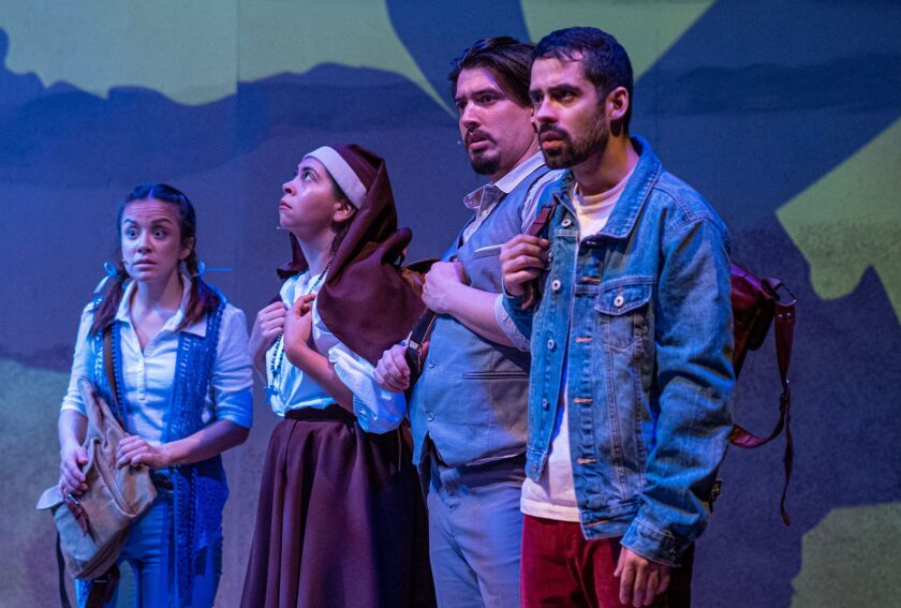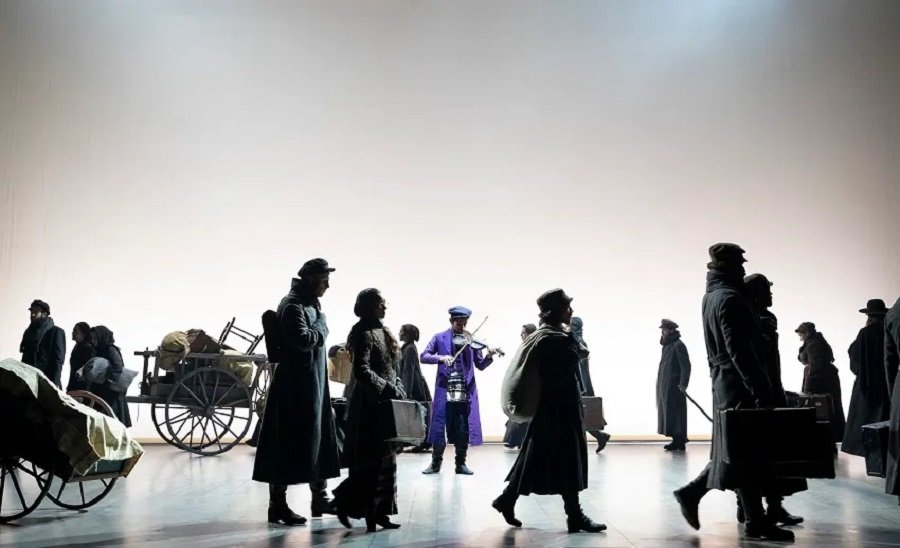I was 11 in the fall of 1990 when my parents took me and my 9-year-old sister to the third Broadway revival of Fiddler on the Roof. Never had a show felt so familiar yet so revelatory; it became, and remains, my favorite musical. So when Broadway in Chicago welcomed the new Bartlett Sher production in May, featuring the sublime Israeli actor Yehezkel Lazarov, I jumped at the chance to take my own children, who are also now 9 and 11. Fittingly, their grandfather gifted us the tickets.
Grasping their Playbills and donning their masks, they tiptoed reverently into the orchestra of the Cadillac Palace Theatre beneath the dome of that exuberant century-old Baroque ceiling. This would be their first in-person Broadway (in Chicago) musical—a very different sensory experience than streaming “You’ll Be Back” from Hamilton on an iPad in their pandemic pillow fort. Honestly, it felt a little soon for me to be back, shoulder to shoulder with 2,344 exhaling strangers, but I was determined to pass on my love of this show.
Growing up in Manhattan in a very secular, very assimilated family (Santa never skipped us), Jewish identity to me meant smoked fish from Zabar’s and dancing at my cousin’s bat mitzvah. Not to say I wasn’t mesmerized by my Grandmama’s tale of escaping the Nazis; all that still felt very recent to me as a child of the 1980s. But until I witnessed Tevye’s family driven out of Anatevka, heading, as my father’s great-grandparents had, for Chicago, I’d never considered my family history in the larger context of emigration and diaspora provoked by the Russian pogroms. Yet that is exactly how I got here.
From the goosebump-inducing opening theme to the chairs piled on wagons, I found myself revisiting Fiddler at the convergence of identity, parenting, and current events. And while I expected the show to give my children a window into the lives of our ancestors, what I hadn’t anticipated was how experiencing the play with my socially conscious 11-year-old in the spring of 2022 would spark conversations about everything from the assault on the people of Ukraine (to whom the cast dedicated their performance), to the mainstreaming of the replacement theory, to the racist history of U.S. immigration policy, and finally, yes, to our own family stories of migration and survival, beyond the shtetls of the Pale.

By curtain call I was agonizing over the fate of each villager departing Anatevka with all the disquieting hindsight of the 2020s. Those who fled Russia for refuge in Europe would not be safe for long, while the ones who came to Chicago would fare much better. I am a product of both: My maternal grandmother’s grandmother was born in Odessa, Ukraine, in 1880. Her family migrated to and thrived in Western Europe, which is how my Dutch-born grandmother found herself fleeing the Gestapo in 1938 Vienna, while my American-born grandmother, in split screen, studied sociology at the University of Chicago. Both would become civic leaders, devoting their lives to advocacy.
While acknowledging that America has been a relatively safe place for many Jewish families, compared to Czarist Russia or Nazi-occupied Europe, it is notable that things in the U.S. are becoming measurably more dangerous for Jews. Hate speech is amplified; hate crimes are shrugged off. The chills of antisemitism I felt during the Charlottesville chants progressed into acute hypothermia post-Tree of Life. By the time we got to Jewish space lasers, my terror clocked in at subzero. And, after decades of singing “Dayenu” at my great aunt Phyllis’s Highland Park, Ill., Seder table, July’s parade shooting acutely escalated my fears.
Even so, helping my children contextualize our family’s relative safety as assimilated Jewish Americans under an umbrella of whiteness—in their case, as half-Jewish, half-Italian—begins with offering a historically informed understanding that America has always been and, largely remains, unsafe for Black, brown, and Indigenous families, with safety remaining elusive for our Asian American, Pacific Islander, Middle Eastern, and North African neighbors as well.
All of which was foregrounded the following weekend at Teatro Vista, where I took my son to see another musical, Brian Quijada’s celebratory tale of resilience, Somewhere Over the Border. Reina, a Salvadorian teenager in the 1970s, leaves her newborn son to escape political unrest in the lead-up to that country’s civil war. Seeking America’s comparative safety, she must traverse the desert and, finally, cross the border, claustrophobically concealed beneath a pallet of flowers in the bed of El Gran Coyote de Tijuana’s pick-up truck. The play is inspired by the journey of Quijada’s own mother, who was in the audience the day we attended.
Reina’s story begins where Tevye’s story ends: as a refugee. We take it for granted that Tevye, Golde, and their remaining daughters will be welcomed in Chicago—Sher made it explicit by having Lazarov bookend the play in modern dress, as Danny Burstein did in the Broadway production. But for the travelers in Somewhere Over the Border, the dignity of the asylum my own family enjoyed remains an empty promise.

As my son pressed me for context around these compounded injustices, I scrambled to offer an ad hoc primer on how America has awarded or withheld refuge over a century and a half of racist immigration policy, from the Chinese Exclusion Act to toddlers in cages, evils that emerged in the long shadow of the Middle Passage and the Trail of Tears.
Political violence in musical theatre is often defanged. During the real pogroms, there was much more mass murder and systemic rape, and far fewer apologetic constables popping in to give a friendly heads-up, than you’d know from Fiddler. Fortunately, Sher (whose Lithuanian-born father was, like Tevye, forced out of the shtetl) holds space for the political realities of the former. In his production, after Russian soldiers exit the ruined wedding, having brutalized Perchik, there comes a long and incongruous sound cue: glass breaking in stereo. It’s way, way more glass than ever could have graced the windows of a thousand Anatevkas; it is Kristallnacht anticipated. The house went silent with recognition. And dread.
Parents exposing children to history by way of musicals must similarly correct for all the romanticized poverty and linger longer on the ugly stuff: Hunger can never be beautiful; state violence has no check valve. Bad, bad things happened, and continue to happen, to many, many innocent people.
How, then, to respond? Resistance or retreat? Fight or flight? The play honors the logic, and courage, of both. Perchik and Hodel become revolutionaries. He’s arrested in Kiev; she follows him to Siberia, determined to end Russian imperialism (in its 1905 incarnation). Was it all for naught? That may depend on when you’re watching. In 1990 I saw Tevye bundle his daughter in that scarf 12 months after the fall of the Berlin Wall, 14 months before the collapse of the Soviet Union; it felt inevitable. My son saw Tevye offer his scarf to Hodel a week after Buffalo, a week before Uvalde, and three months deep into bloodshed across the Ukraine; it felt impossible.
Hodel rushes in for that final hug. “See that she dresses warm,” Tevye implores a silent God, parent to parent.
One scarf vs. Siberia.
On my way to the performance, I imagined that “Sunrise, Sunset” would resonate most for me as a parent watching my kids grow up. But no: It was the ever-mournful “Sabbath Prayer” sequence that left me unexpectedly devastated. As dusk descends on their soon to be abandoned homes the mothers and fathers plead in unison:
May the Lord protect and defend you
May the Lord preserve you from pain
Favor them, Oh Lord, with happiness and peace
Oh, hear our Sabbath prayer, Amen
Each day I read the paper in anguish, wondering: How can I prepare my children for a dangerous world? The play here offers some tools: acceptance, trust, and a fortifying embrace. In the dark of the Cadillac Palace, I snuggled my son closer in our seats.
Hallie Palladino is a playwright in Chicago. Her play The Cleanup premieres at Prop Thtr this October.


